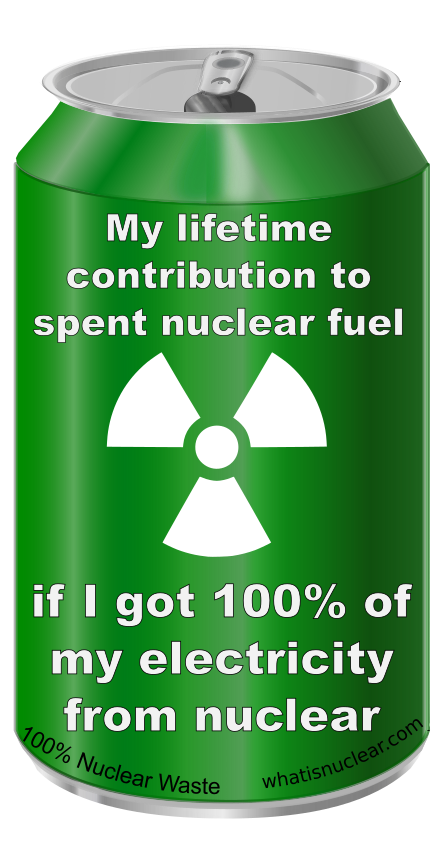How much nuclear waste would you make if you got 100% of your electricity from nuclear power?
By Nick Touran, Ph.D., P.E., 2008-09-08 , Updated 2023-04-29 , Reading time: 4 minutes
This explains the amount of nuclear waste/spent fuel each person in the USA would generate if all electricity came from nuclear power. First, we need to know how much nuclear waste is generated for each bit of electricity created from nuclear power. To do this, we check the EIA for yearly waste discharge data [EIA]. The latest year reported at time of writing is 2017.
| Reactor type | Discharge (MT) | Avg. Burnup (GWd/MT) | Energy Released (GW-year (thermal)) |
|---|---|---|---|
| PWR | 1526 | 46.2 | 193 |
| BWR | 748.1 | 46.4 | 95 |
| Total | 2274.1 | - | 288 |
Now we need to know the average thermal efficiency of the US nuclear fleet so we can convert the thermal power into electrical power. Usually, nuclear power plants run at an efficiency of around 33%, but we want more than an estimate here. Using data from the NRC, we summed up the licensed thermal rated powers of all the reactors in the USA and the net electrical output of the same reactors. The ratio, \(\epsilon_{th} = \frac{P_{electric}}{P_{thermal}}\) gives the efficiency. We found \(\epsilon_{th}\) = 32.3%.
Now we show that 0.0028 grams of nuclear waste are produced for every kWh of electricity generated by nuclear power plants (using GNU units to handle the unit conversions):
units -1 --digits 2 "2274.1 tonne/(288 GW*year * 0.323)" "grams/(kWh)"
0.0028
Per capita electricity usage in the USA is obtained by dividing the total US electricity usage by population. According to the EIA, electricity consumption in 2022 was 4.05 trillion kWh. According to census.gov, the population in 2022 was 332.9 million. Thus, the per capita electricity usage is 12,000 kWh/person.
units -1 --verbose --digits 2 "4.05 trillion kWh/332.9 million" "kWh"
4.05 trillion kWh/332.9 million = 1.2e+04 kWh
Multiplying the values, we now find that each person would generate 34 grams of waste per year if 100% of their electricity came from nuclear energy.
units -1 --verbose --digits 2 "(1.2e4 kWh/year)*(0.0028 grams/kWh)" "grams/year"
(1.2e4 kWh/year)*(0.0028 grams/kWh) = 34 grams/year
For a lifetime, the average life expectancy at birth is 76.4 years according to the CDC, so if you got 100% of your electricity from traditional nuclear power plants for your entire life, you’d be responsible for 2.6 kg (5.7 lbs) of waste.
units -1 --verbose --digits 2 "76.4 years * (1.2e4 kWh/year)*(0.0028 grams/kWh)" "kg"
76.4 years * (1.2e4 kWh/year)*(0.0028 grams/kWh) = 2.6 kg
Volumetrically, the uranium oxide waste has a density around 10 \(g/cm^3\), thus, if you got 100% of your electricity from nuclear power, then:
- You’d make 0.11 fl. oz of nuclear waste per year
- You’d make 8.7 fl. oz of nuclear waste per lifetime (less than a 12 floz soda can)
Supporting calcs:
units -1 --verbose --digits 2 "(1.2e4 kWh/year)*(0.0028 grams/kWh)/(10 grams/cm^3)" "floz/year"
(1.2e4 kWh/year)*(0.0028 grams/kWh)/(10 grams/cm^3) = 0.11 floz/year
units -1 --verbose --digits 2 "76.4 years*(1.2e4 kWh/year)*(0.0028 grams/kWh)/(10 grams/cm^3)" "floz"
76.4 years*(1.2e4 kWh/year)*(0.0028 grams/kWh)/(10 grams/cm^3) = 8.7 floz
What if we used breeder reactors and recycling?
These calculations assume you’re using traditional reactors without recycling the nuclear waste. However, if and when nuclear power makes that much electricity, we plan to shift to breeder reactors that get much more energy out of each kg of fuel. If we used breeder reactors and full recycling, the average burnup would approach 800 GWd/tonne, and the thermal efficiency will approach 39%. The waste density would be lower, since more of it would be converted to fission products.
Then, the conclusions are even wilder. If you got 100% of your electricity from nuclear breeder reactors:
- You’d make 0.011 fl. oz of nuclear waste per year
- You’d make 0.83 fl. oz of nuclear waste per lifetime (6% of a 12 floz soda can)
Calculations:
units -1 --verbose --digits 2 "(1.2e4 kWh/year)/(800 MW*day/kg*0.39)/(5 grams/cm^3)" "floz/year"
(1.2e4 kWh/year)/(800 MW*day/kg*0.39)/(5 grams/cm^3) = 0.011 floz/year
units -1 --verbose --digits 2 "76.4 years * (1.2e4 kWh/year)/(800 MW*day/kg*0.39)/(5 grams/cm^3)" "floz"
76.4 years * (1.2e4 kWh/year)/(800 MW*day/kg*0.39)/(5 grams/cm^3) = 0.83 floz
The 2008 version of this calc is here for posterity.
This page is a part of our Factlet collection.
